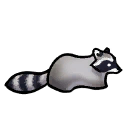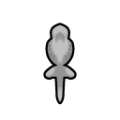Raccoon
| This article is suggested to be rewritten. Reason: Odyssey adds foraging. You can help the RimWorld Wiki by improving it. |
Raccoon
A small, hardy animal that ranges wide across forests and shrubland. It is happy to break into your garbage container, or your kitchen, to eat almost anything.
Base Stats
- Type
- Animal
- Flammability
- 70%
Pawn Stats
- Combat Power
- 35
- Move Speed
- 4.1 c/s
- Health Scale
- 40% HP
- Body Size
- 0.4
- Mass - Baby
- 4.8 kg
- Mass - Juvenile
- 12 kg
- Mass - Adult
- 24 kg
- Carrying Capacity
- 30
- Filth Rate
- 4
- Hunger Rate
- 0.32 Nutrition/Day
- Diet
- omnivorous grazer
- Life Expectancy
- 8 years
- Coastal Animal
- false
- Manhunter Chance
- 0%
- Manhunter Chance (Taming)
- 0%
- Trainable Intelligence
- None
- Wildness
- 75%
- Minimum Handling Skill
- 8
- Mate Interval
- 8 hours
- Maturity Age
- 0.222 years (13.3 days)
- Juvenile Age
- 0.1 years (6 days)
- Toxic Resistance
- 50%
- Toxic Environment Resistance
- 80%
- Comfortable Temp Range
- -30 °C – 40 °C (-22 °F – 104 °F)
Production
- Meat Yield
 56 raccoon meat
56 raccoon meat- Leather Yield
 22 lightleather
22 lightleather- Gestation Period
- 5.661 days
- Offspring Per Birth
- 1-2 (1.5 avg)
Melee Combat
- Attack 1
- Front left paw
6 dmg (Scratch)
9 % AP
2 second cooldown - Attack 2
- Front right paw
6 dmg (Scratch)
9 % AP
2 second cooldown - Attack 3
- Teeth
7 dmg (Bite)
10 % AP
2 second cooldown
0.7 chance factor - Attack 4
- Head
3 dmg (Blunt)
4 % AP
2 second cooldown
0.2 chance factor - Average DPS
- 1.9406
- tradeTags
- AnimalCommon
The raccoon is a small ground mammal which scavenges for most of its food.
Acquisition[edit]
Raccoons can be found in temperate forests, temperate swamps, boreal forests, cold bogs, glacial plains![]() , glowforests
, glowforests![]() , grasslands
, grasslands![]() , and scarlands
, and scarlands![]() . They can either be tamed by a handler or self-tame in a random event.
. They can either be tamed by a handler or self-tame in a random event.
Summary[edit]
Raccoons have 80% Toxic Environment Resistance rendering them highly resistant to environmental effects such as rot stink, as well as toxic buildup from non-attack sources.
Analysis[edit]
Raccoons are mostly there as small manhunter threats for your small manhunter events. For the first manhunter event in the game, raccoons are about the largest animal you'll get. They can also appear in the low end of caravan ambushes, or in the Noble wimp![]() quest. During the winter, raccoons will often eat any of your exposed food you have available.
quest. During the winter, raccoons will often eat any of your exposed food you have available.
As hunting game, they yield about 50% more meat and leather than the smallest RimWorld animals (the hare, squirrel, and rat), but they still offer meager amounts of both. Prioritize other animals unless have nothing else to hunt or want a relatively safe target for training Shooting skill.
As tamed animals, raccoons offer practically no niche. They gestate slower and lose tameness faster than rats. Rats are also omnivorous grazers. You can find rats in every biome that raccoons appear in, and rats are more common than raccoons. As bait animals, rats are harder to hit due to their smaller body size, reproduce faster, and eat less.
Raccoons consume 0.32 nutrition a day and can only forage for 0.24. This means that unlike pigs, foraging will not fully offset their hunger.
Foraging[edit]
| Forager | Forage Nutrition per day |
|---|---|
| Raccoon | .24 |
| Pig | 1.02 |
| Wild Boar | .51 |
| Gorilla | 1.2 |
| 10 Plants Skill Pawn | 0.9 |
Training[edit]
This animal can be trained as follows:
| | |
| | |
| | |
| |
*As of version 1.1.2610, all animals can be tamed. The percentage of likelihood of success depends on factors such as the Animals Wildness Percentage, Pawn Handling Skill, and others. More information can be found on the animals page.
![]() In addition, a Raccoon can be trained to perform 'Forage': “The animal will occasionally find berries, mushrooms, or food. Animals will find more food in biomes with higher forageability. Foraging can only be done on fertile terrain.”
In addition, a Raccoon can be trained to perform 'Forage': “The animal will occasionally find berries, mushrooms, or food. Animals will find more food in biomes with higher forageability. Foraging can only be done on fertile terrain.”
Health[edit]
The body part table is collapsed due to length. Expand to view.
| Part Name | Health | Quantity | Coverage[1] | Target Chance[2] | Subpart of | Internal | Capacity[3] | Effect if Destroyed/Removed |
|---|---|---|---|---|---|---|---|---|
| Body | 16 | 1 | 100% | 26% | N/A[4] | - | Death | |
| Spine | 10 | 1 | 3% | 3.0% | Body | Moving |
−100% Moving[5] | |
| Stomach | 8 | 1 | 3% | 3.0% | Body | Digestion |
−50% Digestion | |
| Heart | 6 | 1 | 3% | 3.0% | Body | Blood Pumping |
Death | |
| Lung | 6 | 2 | 3% | 3.0% | Body | Breathing |
−50% Breathing. Death if both lost | |
| Kidney | 6 | 2 | 3% | 3.0% | Body | Blood Filtration | −50% Blood Filtration. Death if both lost | |
| Liver | 8 | 1 | 3% | 3.0% | Body | Digestion |
Death | |
| Neck | 10 | 1 | 22% | 22% | Body | Eating Talking Breathing |
Death | |
| Head | 10 | 1 | 75% | 9.9% | Neck | - | Death | |
| Skull | 10 | 1 | 25% | 1.2375% | Head | - | Cannot be destroyed Increasing Pain based on damage. | |
| Brain | 4 | 1 | 70% | 2.8875% | Skull | Consciousness |
Death Damage always results in scarring. | |
| Eye | 4 | 2 | 12% | 0.495% | Head | Sight |
−25% Sight. −100% if both lost. Damage always results in scarring. 0% Hit Chance against Blunt damage. | |
| Ear | 4.8 | 2 | 8% | 0.33% | Head | Hearing |
−25% Hearing. −100% if both lost. −15 Disfigured Social penalty | |
| Nose | 4 | 1 | 10% | 0.4125% | Head | - | −15 Disfigured Social penalty | |
| AnimalJaw | 4 | 1 | 10% | 0.4125% | Head | Manipulation |
−100% Manipulation. Can no longer use Bite attack. | |
| Front Leg | 12 | 2 | 7% | 5.95% | Body | Moving |
−25% Moving. −50% if both lost. Can no longer use paw attack[6] | |
| Front Paw | 4 | 2 | 15% | 1.05% | Front Leg | Moving |
−25% Moving. −50% if both lost. | |
| Rear Leg | 12 | 2 | 7% | 5.95% | Body | Moving |
−25% Moving. −50% if both lost | |
| Rear Paw | 4 | 2 | 15% | 1.05% | Rear Leg | Moving |
−25% Moving. −50% if both lost |
- ↑ Coverage determines the chance to hit this body part. It refers to the percentage of the super-part that this part covers, before its own sub-parts claim their own percentage. For example, if the base coverage of the super-part is 100%, and the coverage of the part is 20%, 20% of hits would hit the part, and 80% the super-part. If the part had its own sub-part with 50% coverage, the chances would be 10% sub-part, 10% part, 80% super part.
- ↑ Target Chance is the actual chance for each part to be be selected as the target when each part's coverage has been taken into account(I.E. Neck covers 7.5% of Torso but Head covers 80% of Neck so it actually has only a 1.5% chance to be selected). This is not pure hit chance, as different damage types propagate damage in different ways. See that page for details.
- ↑ Note that capacities can affect other capacities in turn. Only the primary effect is listed. See specific pages for details.
- ↑ This is the part that everything else connects to to be considered 'connected'.
- ↑ If Moving drops below 16% a pawn cannot move.
- ↑ A Scratch attack that varies from animal to animal. Each front paw allows one attack.
Attack table
| Attack (Damage type) |
DPS[1] (Post Hit Chance)[2] |
Dam. | Cool. | AP | Selection chance[3] | |
|---|---|---|---|---|---|---|
| Average | 3.13 (1.94) |
- | - | 9.25% | - | |
| Front left paw (Scratch) |
3 (1.86) |
6 | 2s | 9% | 37.5% | |
| Front right paw (Scratch) |
3 (1.86) |
6 | 2s | 9% | 37.5% | |
| Teeth (Bite) |
3.5 (2.17) |
7 | 2s | 10% | 25% | |
| Head (Blunt) |
1.5 (0.93) |
3 | 2s | 4% | 0% | |
- ↑ Note: This is the actual base average derived from the melee verb system updated in 1.1.2610, it may sometimes disagree with the listed value in the in-game infobox.
It may also change depending on the stats and the melee verbs available to the pawn. - ↑ Assuming a melee hit chance of 62%
- ↑ Chance for attack to be selected. It may change depending on the melee verbs available to the pawn.






